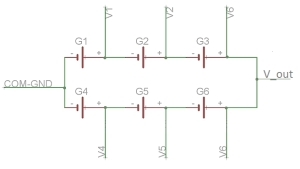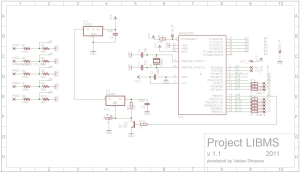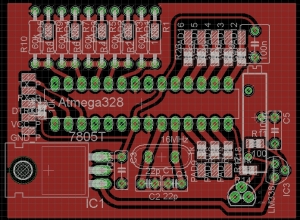Category Archives: Uncategorized
Readiness For Change test
My workplace wanted an HTML + JS implementation of a questionnaire that their users could perform and test their clinical practice. I was given an overall design of the page and had to implement it.
Everything is handled by the JavaScript that’s running client-side.
You can check it out here.
And please take a look at the Change Guide here (requires registration).
Epic Re:load v2 modifications
I have decided to upgrade the radiator for the FET to a bit larger one. I’ve also made some mountings form L shaped brackets for the potentiometer and have changed the original one to a 10 turn one.
Also, I managed to a really awesome knob for the 10 turn pot. The cool thing is that it calculates the turns and always shows the position that the potentiometer is at.
The original radiator resulted in the FET’s thermal protection kicking in when running larger loads. That’s the main reason for this “upgrade”. The radiator I used is probably a bit too large for what I want to achieve, but it can definitely dissipate the heat that the FET produces.
I could not find any box laying around that the dummy load could be mounted in, so I opted out for mounting everything on the radiator itself. In the final version I moved the control knob and the banana connectors (can be seen in the title photo) to the other side of the radiator so that it’s way more compact.
I do really like the final result. Of course, I should at least file the L brackets to make it look nicer, but the dummy load does what it’s supposed to do.
Please see a video overview of the whole process on my YouTube channel here:
Project LIBMS: Li-Ion Battery Monitoring System
LIBMS by Vaidas Sirtautas is licensed under a Creative Commons Attribution-NonCommercial-ShareAlike 3.0 Unported License. Permissions beyond the scope of this license may be available at https://sadiav.wordpress.com
Video
or you can watch in HD on Youtube.
Problem
Let’s start with a problem…
In order to have my phone as well as my BlueTooth audio headset working I had to carry two different chargers to workplace. Moreover, I needed to find an unused socket to plug them in. And that’s really annoying…
Idea
I could see two possible solutions:
- Buy a charger that uses batteries and provides 5V to charge my devices
- Build one of my own
And, of course, I went with choice #2. I had some Lithium Ion batteries lying around. And this was the starting point of LIBMS.
LIBMS
It would be crazy to just power devices through some voltage regulator. LiIon cells do not like to be discharged below 3V and without some additional circuitry it was impossible to check whether they were OK to continue providing power to the devices. (Well, I could carry a multimeter and measure each of them from time to time, but that would be crazy :))
I found some IC’s that are capable of monitoring LiIon batteries, but where’s the fun in that…
I had some Atmega328 chips laying around. They have a 6 channel 10-bit ADC (there is actually only one ADC, but built-in multiplexer expands the inputs to 6). Awesome.
Batteries
I connected 3 of the batteries in series and then that block with another block of three batteries in parallel. V1..V6 show my tap points that are used to measure each cells voltage. E.g.
- V(G2) = V2 – V1
- V(G3) = V6 – V(G2)
- …
- V(G6) = V6 – V(G5)
Voltage regulators
At the beginning of this project I had some problems with voltage regulation. I powered the microcontroller (uC) directly from the main voltage regulator (LM338), but when a device was connected that requires a lot of current the voltage suddenly dropped and uC restarted. Not good…
I solved this problem by introducing secondary LM7805 voltage regulator that is used to power the uC and LM338 takes care of the USB ports. Using this structure provided me with a cool way for controlling the USB ports from uC.
Browsing through the LM338’s data-sheet I found an example where the regulator can be controller using a TTL signal. Perfect. Even though it does not shut down completely (there is still ~1.25V on the output), it does the job.
Sensing part
Because Atmega328 can measure up to 5V max, I had to scale down the voltages of the cells. To do that I used voltage dividers. There are 5 of them, connected to ports A0..A4. Resistors (with values specified) are R1..R10 in the schematic.
Schematic & PCB layout
*Click on the images for hi-res version.
There is a 10K pull-up resistor (not shown in schematic) connected from BC337 base to Vcc to ensure that Voltage regulator stays off while uC is starting up.
Code
This code was written using Arduino IDE (www.arduino.cc)
int analogValues [5];
int voltages[6];
unsigned char i; // Loop variable
byte LEDs = 0;
byte tempLEDs = 0;
boolean turnOn = true;
boolean updated = false;
boolean firstrun = true;
byte portVal;
byte LEDstates[] = {
0xFF, 0xDF, 0x9F, 0x1F, 0x0F, 0x07, 0x03, 0x01, 0x00};
void setup()
{
// Set Transistor's pin to output
pinMode(8, OUTPUT);
digitalWrite(8, HIGH);
// Set LED pins to outputs
pinMode(5, OUTPUT);
pinMode(6, OUTPUT);
pinMode(7, OUTPUT);
pinMode(9, OUTPUT);
pinMode(10, OUTPUT);
pinMode(11, OUTPUT);
pinMode(12, OUTPUT);
pinMode(13, OUTPUT);
// Set analog inputs
pinMode(A0, INPUT);
pinMode(A1, INPUT);
pinMode(A2, INPUT);
pinMode(A3, INPUT);
pinMode(A4, INPUT);
// Disable Pull-up resistors on analog pins
digitalWrite(A0, LOW);
digitalWrite(A1, LOW);
digitalWrite(A2, LOW);
digitalWrite(A3, LOW);
digitalWrite(A4, LOW);
for (i = 0; i < 9; i++)
{
tempLEDs = LEDstates[i];
updateLEDs();
delay(500);
}
delay(1000);
}
void updateLEDs()
{
PORTD = (PORTD & 0x1F) | (tempLEDs & 0xE0);
PORTB = (PORTB & 0xC1) | ((tempLEDs & 0x1F) << 1);
}
// Scale because of voltage divider by 2.624
void loop()
{
if (turnOn && updated)
{
digitalWrite(8, LOW);
updated = false;
}
if (!turnOn && updated)
{
// Serial.println("turn OFF");
digitalWrite(8, HIGH);
updated = false;
}
// Read status of all batteries
for (i = 0; i < 5; i++)
{
analogValues[i] = analogRead(i);
delay(10);
}
voltages[0] = analogValues[4];
voltages[1] = analogValues[3] - voltages[0];
voltages[2] = analogValues[2] - voltages[1] - voltages[0];
voltages[3] = analogValues[1];
voltages[4] = analogValues[0] - voltages[3];
voltages[5] = analogValues[2] - voltages[4] - voltages [3];
// Take care of low voltage per cell situations
// Minimum threshold for a cell is 3.0V.
// Minimum value is 3/(5/1024) = 614.4
// Scaled because of voltage divider by 2.624,
// so 3V = 614/2.624 = 234 units
boolean stopLoop = false;
i = 0;
while ( i < 6 && !stopLoop)
{
if (voltages[i] < 234)
{
stopLoop = true;
turnOn = false;
updated = true;
digitalWrite(8, LOW);
// Enter infinite
loop while (1) { };
}
i++;
}
//Serial.println(analogValues[2], DEC);
// Take care of LED's
if (analogValues[2] > 920) // 11.8V
tempLEDs = LEDstates[0];
else
if (analogValues[2] > 889) // 11.4V
tempLEDs = LEDstates[1];
else
if (analogValues[2] > 858) // 11.0V
tempLEDs = LEDstates[2];
else
if (analogValues[2] > 827) // 10.6V
tempLEDs = LEDstates[3];
else
if (analogValues[2] > 796) // 10.2V
tempLEDs = LEDstates[4];
else
if (analogValues[2] > 765) // 9.8V
tempLEDs = LEDstates[5];
else
if (analogValues[2] > 734) // 9.4V
tempLEDs = LEDstates[6];
else
tempLEDs = LEDstates[7];
// Something changed in total battery voltage
if (LEDs != tempLEDs)
{
LEDs = tempLEDs;
updateLEDs();
/* My old idea...
// First three LED's
tempLEDs = tempLEDs >> 5; // Right shift by 5 to get first three bits
tempLEDs = tempLEDs << 5;
portVal = PORTD;
portVal = portVal << 3; // Right shift to get rid of last three bits; portVal = portVal >> 3; // Left shift to restore first 5 bits to their positions
PORTD = portVal | tempLEDs;
// Restore temp value that changed because of all the shifting
tempLEDs = LEDs;
// Last five LED's
portVal = PORTB;
tempLEDs = tempLEDs << 3; // get rid of first three bits tempLEDs = tempLEDs >> 2; // position temp byte correctly
if (turnOn) tempLEDs = tempLEDs | 1;
PORTB = tempLEDs;
// Restore temp value that changed because of all the shifting
tempLEDs = LEDs;
*/
}
if (firstrun)
{
updated = true;
turnOn = true;
firstrun=false;
}
// Delay before next run
delay(1000);
}
Eagle files
Will be uploaded later
KatMouse issues
I’ve set up a new system at home to use as my primary PC. That, of course, required reinstalling all of the programs I use daily.
Firstly it was Firefox and then KatMouse. (KatMouse is an amazing little app that does not require you to have window activated in order to scroll it. You just have to keep your mouse cursor over it.)
I got myself in a huge problem. My Logitech Anywhere MX mouse could not close tabs or open links via middle button click.
By default in Logitech’s Set Point software it’s set as “Application Switcher”. I, of course, changed it to “Middle Button”.
Everything should be fine, but no… It was still switching between windows as previously. That got me mad… I even created post on Logitech support forums. After a while playing with KatMouse‘s settings I finally figured out where the problem is.
In the settings in the Wheel Button tab None of the buttons should be selected “as push button”.
Then everything works like a charm :).
Nitro tutorials (video)
After playing with my HPI Trophy 3.5 I stared on looking for more info about the way to take care of the engine and the car itself. Today I found an amazing series with tutorials related to Nitro engines.
Series was created by Squirrelod. Tutorials really helped me to understand the inner parts of a nitro engines. Please take a look 😉
Complete list of the videos in the series:
- Vid 1 Tuning basics
- Vid 2 Stock needle settings
- Vid 3 Weather effects
- Vid 4 Fuel and glow plugs
- Vid 5 Shims
- Vid 6 reading engine temps
- Vid 7 Onsite HSN tuning
- Vid 8 Onsite LSN tuning
- Vid 9 Onsite Idle screw tuning
- Vid 10 running signs of rich, lean, and tuned
- Vid 11 Glow plugs 101
- Vid 12 air leak detection
- Vid 13 sealing air leaks
- Vid 14 compression 101
Unfortunately videos are not in high quality, but everything is quite viewable…
Hello
Hello to everyone, it’s time to start blogging.
Mostly this blog will consist of info about the projects I’m working on.
You can find more info about me on
- facebook: www.facebook.com/vaidas.sirtautas
- twitter: www.twitter.com/sadiav
- youtube: http://www.youtube.com/user/V4id4s1987
hopefully it’s going to be fun for both you, my reader, and me.








